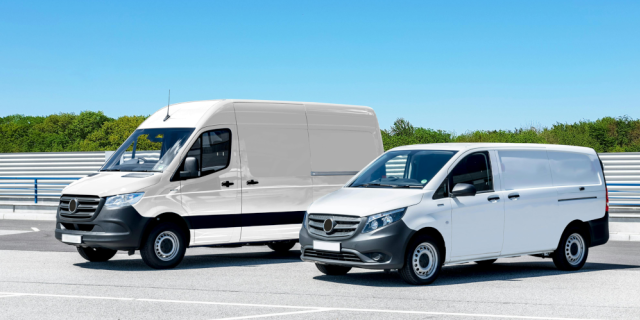Our world is getting ever more urbanised, which exasperates the need for commercial vehicles that are light, agile and versatile. Light Commercial Vehicles (LCVs) have become an increasingly important part of our transportation system.
As the pandemic brought with it the home-working and home-delivery boom, the LCVs have met the challenge. Now, the European LCV market is set to grow from €58bn in 2021 to €75bn in 2026. The global LCV market is expected to reach €735 billion by 2030.
A European Commission study claims that “high penetration of eLCVs alone”, or 34% of market composition at the end of the next 7-year period, “can lead to a reduction of total transport CO2 emissions by more than 3% by 2030.“
With this increased usage and the growing environmental impact comes the need for optimisation of the systems and vehicles.
Let’s explore a few of the creative optimisation options to LCV fleet managers today.
The Right LCV: optimised efficiency of fleet & drivers
Our world is getting ever more urbanised, which exasperates the need for commercial vehicles that are light, agile and versatile.
Light Commercial Vehicles (LCVs) have become an increasingly important part of our transportation system.
As the pandemic brought with it the home-working and home-delivery boom, the LCVs have met the challenge. Now, the European LCV market is set to grow from €58bn in 2021 to €75bn in 2026. The global LCV market is expected to reach €735 billion by 2030.
According to a 2019 study by the European Commission, the transport sector, apart from being “one of the main levers of development” is “also a main carbon dioxide (CO2) and pollutant emitter.”
In 2017, the sector was responsible for 27% of the EU's total greenhouse gas (GHG) emissions, with LCVs producing around 9% of those transport emissions.
The aforementioned European Commission study claims that “high penetration of eLCVs alone”, or 34% of market composition at the end of the next 7-year period, “can lead to a reduction of total transport CO2 emissions by more than 3% by 2030.“
With this increased usage and the growing environmental impact comes the need for optimisation of the systems and vehicles.
Let’s explore a few of the creative optimisation options available to LCV fleet managers today. Firstly, optimising the journey itself is key.
Real-time tracking and various routing options available on a consumer or commercial GPS are a must for progress monitoring, scheduling and issue management.
If a vehicle encounters a fault whilst en route, a swift replacement can be sent out or another driver can be rerouted to minimise latency and ensure order fulfilment.
Quickly informing all the stakeholders, including warning the customer of the potential delay and service staff about a vehicle coming in for repair and real-time data supercharges fleet managers’ tools, saves precious time for everyone involved.
Enabled by data, improved dispatch and routing reduce fuel consumption and delivery times, - eliminating haste, - which in turn prolongs the vehicle’s life and increases driver and customer satisfaction.
Geofencing creates virtual boundaries around specific locations, setting up alerts and notifications to track when the vehicle enters or exits a certain area. This ensures the drivers are safe, the vehicles are not misused, and, if stolen, can be recovered quickly.
Electric LCVs are known for their motor-to-wheels energy efficiency, their role in emissions reduction, quiet operation and lower maintenance costs.
Regardless of the powertrain, several optimisations can be made, mainly in fuel and energy consumption, and maintenance.
Information on driver behaviour, collected via cockpit and external cameras, as well as telematic sensors, can be especially useful for optimising fuel consumption.
According to The US Department of Energy’s study of various vehicle types, including Light-Duty Vehicles, “aggressive driving behaviour, characterised by speeding and rapid acceleration and braking, can lower fuel economy by 15%–30%”.
Incentivising good driving practices via point systems and training can save a business time and money spent on excessive wear and tear, but, most importantly, post-accident damage repair and insurance premiums. The optimal driving technique is measured and calm. Driver education on the matter is paramount.
We previously mentioned preventative maintenance. It is a great way to ensure a business is optimised to run more efficiently.
For LCVs, regular oil changes, tire rotations, and other routine maintenance including technical checks of the entire vehicle from the front plate to the rear plate ensure that the vehicle runs efficiently.
By tracking the usage of the LCV, one can get a better understanding of how it is being used and identify areas for improvement.
If a business did decide to acquire an eLCV, one way to optimise energy consumption would be to set a charging strategy at the company’s own depot. Charging the vehicle on the company's electrical system might be the most cost-effective solution.
Various European states will support corporations in this endeavour. For example, in the UK, a grant covers up to 75% of the total costs of the purchase and installation, Germany covers 80% with local municipalities having their additional incentives.
Lastly, if the vehicle and the charger are outfitted with Vehicle to Grid (V2G) capabilities, the vehicle’s battery can act as a storage device for the excess electricity supplied by the grid, feeding it back if and when needed. This helps stabilise the local electrical infrastructure and may result in a lower electricity bill.
Organising the equipment in an LCV is crucial for ensuring the productivity of the technicians who use it. Staff must have easy access to the tools and equipment they need. By having everything the drivers need easily accessible and safely secured, they can spend less time searching for tools and equipment and more time completing tasks, improving performance and cost savings for the business, making it a worthwhile investment in the long run.
Driver satisfaction is a crucial aspect in the optimisation of the fleet meaning that they have to work in a safe and comfortable environment.
Attracting and retaining a workforce focused on sustainability and reducing environmental impact can prove crucial for vehicle operations in the long run.
To entice drivers who will contribute to the CSR targets, companies can offer incentives, such as bonuses or other rewards for meeting sustainability targets, providing opportunities for professional development and career growth.
It is key to communicate the company's environmental values and sustainability goals clearly, as potential employees seek a connection between their role and the company's overall mission.
LCVs have proven to be a valuable tool, fulfilling the needs of our urban environments. eLCVs go further, helping companies meet their CSR goals and maximising profits for sustainable businesses. How do you optimise your fleet and driver satisfaction?
Do you want to read more Arval Mobility Observatory news?
You find the Arval Mobility Observatory newsroom here.




